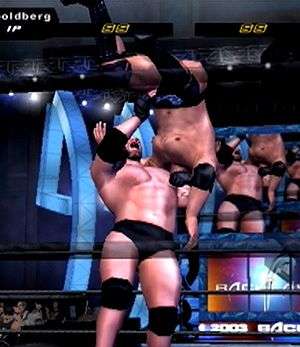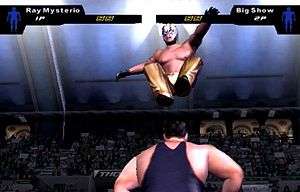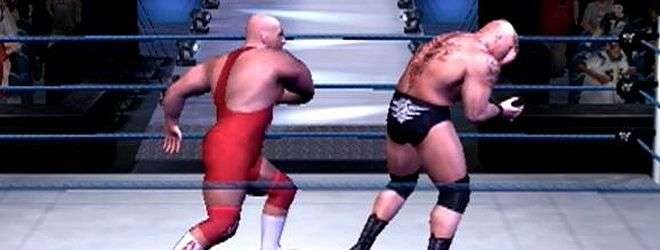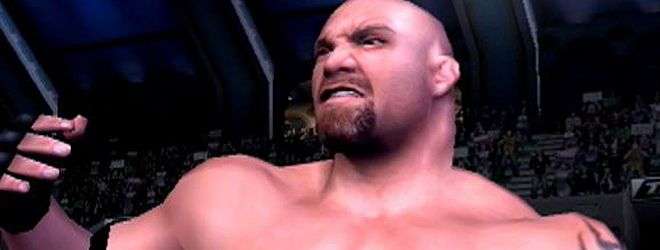I Heart… Smackdown! Here Comes The Pain
by Edward
 It’s my life, my time, my rights, my rhymes, my grime, my struggle, hustle, sweat and my blood too. My predator smells fear, and I smell a lot. My competitors fled scared, ’cause they smelt I was hot. I want it all in excess, the sex, and much success, stress sucks, I want it all, no less. So, come on!
It’s my life, my time, my rights, my rhymes, my grime, my struggle, hustle, sweat and my blood too. My predator smells fear, and I smell a lot. My competitors fled scared, ’cause they smelt I was hot. I want it all in excess, the sex, and much success, stress sucks, I want it all, no less. So, come on!
As you can no doubt guess from the fact that you’re reading this on a website about videogames, I wasn’t the most mature or popular teenager around. Whenever I get retrospective or nostalgic on GamingLives it’s nearly always about some sort of comedy, point-and-click, or combination of the two, but there’s one part of my life that I’ve never found myself enthusiastically diving into – my wrestling phase.
I can fire off the excuses with near-laser precision; an older boy talked me into it. All the other kids my age were into it and I didn’t inhale, honest. Yet, every Saturday I’d flick on the TV, turn to Sky One and unwind watching grown, sweaty men pretend to kick several shades of shit out of each other. I’d been briefly exposed to the Attitude Era and that weird storyline where the WCW were pretending to take over but they were all employed by the then-WWF so there was no risk involved, and to this day I still remember “Stone Cold” Steve Austin walking out of a freezer downing a carton of milk while trying to scare the crap out of a confused Booker T, but I can’t for the life of me understand why.
The peak of this phase neatly coincided with my parents gifting me a PlayStation 2 for Christmas, although I can’t remember if I’d even asked for one that year; I remember clear as day, however, the only thing I wanted to buy when we hit the Boxing Day sales – a copy of Smackdown! Here Comes The Pain. I still remember queueing up in the heaving GAME store (something wholly unimaginable nowadays), paying the new-game cost of thirty-six pounds (see previous parentheses) and leaving without anyone attempting to get me to buy it pre-owned instead or take out disc insurance (you know where this is going).
 As I loaded up the first PlayStation 2 game I’d willingly bought for myself and the theme music began to play, I could never have suspected that it would be the beginning of a beautiful, years-long love affair. Oh, I’d played the original Smackdown! and Know Your Role back on the original PlayStation, but they never managed to hold my attention the way Here Comes The Pain did, maintaining a vice-like grip on me for at least the next two years of my life.
As I loaded up the first PlayStation 2 game I’d willingly bought for myself and the theme music began to play, I could never have suspected that it would be the beginning of a beautiful, years-long love affair. Oh, I’d played the original Smackdown! and Know Your Role back on the original PlayStation, but they never managed to hold my attention the way Here Comes The Pain did, maintaining a vice-like grip on me for at least the next two years of my life.
With my prime-time viewing of the WWE taking place during their “Ruthless Aggression” phase, where wrestlers would frequently take risks, throw themselves onto tables and take chair shots on a regular basis, my first port of call was to control of my favourite wrestlers, take on my least favourite members of the roster, and throw them in the Elimination Chamber. A new mode for Here Comes The Pain, it was based off the brutal match type where the action was confined to a cell, but two wrestlers started while another four lay in wait, unleashed at random points in the match until five were removed from the equation and one stood tall.
I spent hours attempting to learn the ropes in that chamber, taking on the guise of legends like The Rock and The Undertaker, as well as popular mid-cards like Rey Mysterio, learning their nuances, finishers, and best tactics in taking on the rest of the roster. In a sense, it was the perfect method for me to test the game’s limits, as well as acclimatise to the fast-paced but considered action, requiring you to keep a great balance of quick-thinking combined with long-term tactics.
Also new to the series was the stamina system – an always-present on-screen indicator that would tell you how healthy your wrestler was, with continued damage to key areas changing your head, limbs and torso from blue to yellow, orange, and the dreaded red. Where matches in previous iterations of the Smackdown! franchise would come down to who could earn and use their finishers first, now it became about sufficiently weakening your opponent to the point that hitting your signature moves just gave you a bigger chance of getting the pin-fall, rather than a guarantee. Landing a choke-slam, pedigree, or People’s Elbow was all well and good, but if your opponent was barely in the yellow then reaching a three-count was nothing more than a pipe-dream.
Later instalments would try to add in momentum as a key mechanic, but this always felt artificial to me – you could be clawing your way to a well-earned victory only for the computer to decide that your opponent had gained their second wind, shortly followed by them landing their best moves on you and your defeat all but an inevitability.
In this regard, I’ve always felt Here Comes The Pain to be flawless; any momentum in the match was entirely yours to earn, the tide of battle dictated by whether you managed to hit the reversal button in time, or by pulling off a risky manoeuvre from the top rope, even if you knew that a botch would leave you sprawled out on the mat, begging for your opponent to get the pin. Every victory you earned was a result of your hard work and attrition, every defeat was nobody’s fault but your own.
 Not every success was a guarantee either, thanks to your stamina. Every injured limb and every stage of damage would make it that bit harder to break out of the pin, until you were so injured that you’d need lightening-fast button tapping skills to get loose before the three-count. Submission moves were also overhauled to take advantage of this, with a meter popping up whenever certain moves were executed. On one side lay the ability to break out of the move, on the other was surrender, and the more damage you’d taken the harder it was to stop yourself from tapping out. Conversely, targeting specific limbs would often become your tactic du jour; knowing that by crippling their legs it’d be that bit harder for them to break out of your four-figure leg-lock was one thing, but actually pulling it off was another thing entirely.
Not every success was a guarantee either, thanks to your stamina. Every injured limb and every stage of damage would make it that bit harder to break out of the pin, until you were so injured that you’d need lightening-fast button tapping skills to get loose before the three-count. Submission moves were also overhauled to take advantage of this, with a meter popping up whenever certain moves were executed. On one side lay the ability to break out of the move, on the other was surrender, and the more damage you’d taken the harder it was to stop yourself from tapping out. Conversely, targeting specific limbs would often become your tactic du jour; knowing that by crippling their legs it’d be that bit harder for them to break out of your four-figure leg-lock was one thing, but actually pulling it off was another thing entirely.
Weakening specific limbs wasn’t just for submissions, but the impact of your finisher could become radically different depending on how badly you’d injured your opponent. Bring a wrestler’s head to red-level damage and hit a move that specifically attacks it, and a blast of red would flash on your screen, with a dynamic camera angle showing your enemy’s noggin covered in their own blood. It’s a sight you’ll seldom see in wrestling nowadays from what I’ve heard, as the company is in the midst of the oft-maligned and kid-friendly “PG Era”, but back in 2003 it was a frequent sight, and one that often spelled victory if you played your cards right.
Frantic action and dangerous moves were one thing, but the WWE was still all about the spectacle, and this was something Here Comes The Pain handled effortlessly. While the viewpoint would remain static for the most part, you always knew you’d stumbled onto one of the more awe-inspiring moments whenever the action would slow down, the camera angle would change and you’d be treated to a beautiful shot not even the actual shows themselves could replicate. Even to this day the thought of the camera swooping low as my wrestler would launch themselves off the top rope, or providing an action replay when your finisher hit is one that sets off minor goosebumps.
 While some of the best moments came from creating moments the TV shows never could, there was an equal amount of fun to be had from trying what you saw at home – as long as you kept it within the confines of your console. Before his untimely demise, one of Eddie Guerrero’s greatest gimmicks was his “Lie, Cheat, Steal” persona, where he’d often win matches by thinking outside of the box and taking advantage of the situation as soon as the referee’s back was turned.
While some of the best moments came from creating moments the TV shows never could, there was an equal amount of fun to be had from trying what you saw at home – as long as you kept it within the confines of your console. Before his untimely demise, one of Eddie Guerrero’s greatest gimmicks was his “Lie, Cheat, Steal” persona, where he’d often win matches by thinking outside of the box and taking advantage of the situation as soon as the referee’s back was turned.
Even his final match was won by noting the referee was knocked out and grabbing a steel chair from outside the ring, then seeing him come to, slamming the chair on the ground, throwing it to his opponent and then lying flat on the ground, tricking the official into thinking that Eddie had been hit by the chair and giving him the win via disqualification. That was a bit too elaborate for the game to handle, but it never meant you couldn’t accidentally hit the ref, grab a chair and lay waste to your opponent without fear of retribution. Deliberately targeting the man would always lead to your moves being countered and your disqualification a foregone conclusion, giving rise to a meta-game I spent ages trying to master; the art of intentionally knocking out the referee by accident.
The amount of time I dedicated to that paled significantly, however, to my true goal – creating the ultimate wrestler. Playing as my favourite superstars was fun for a while, but like every teenager with low self-confidence, I wasn’t going to rest until my name was up in lights and the crowds were screaming my name. A paltry belt or two wasn’t going to be enough; I wasn’t going to stop until I was the best.
I’m almost legendarily terrible at creating characters, and after creating a vague approximation of what I’d look like if I was stronger, more ruggedly handsome and made of polygons, The Destroyer – a name I thought sounded cool and not at all vaguely homoerotic at the time and shut up – was born. Several hours of customising my move-set later, and I was finally ready to take the stage by storm.
My debut was… painful, to say the least. I’d scraped by with the victory, but I found myself severely on the back-foot throughout; as a newly-created wrestler, I’d only been given a paltry number of points with which to boost my stats, and even doing this left me by far the weakest member of the roster.
Each wrestler’s stats were divided into several areas – strength and speed are rather self-explanatory, submission dictated how many seconds those moves would last for, technique helped you perform counters, while endurance increased how much damage you could take until you’re left a bloody heap on the mat. How you chose to mould your own character was completely up to you, but if you truly wanted to stand a chance in your early career then you couldn’t go wrong with strength or endurance; at the end of the day it’s pummel or be pummelled, and both were substantially more difficult if you were a weakling who couldn’t take a punch.
 Every in-game month would lead up to a different Pay-Per-View, and while you wouldn’t be reaching top-billing when you first started out, there’d always be title shots and certain story-lines you could force your way into. Team up with a more popular wrestler and you could try your hand at the Tag Team titles, or reach a certain amount of notoriety and you could see yourself with the US or Intercontinental title in your grubby mitts. All of these were nothing but warm-ups for the main events, and once you’d reached a certain amount of Superstar points – earned through victories and interactions with other wrestlers backstage – you could finally achieve your dream of taking home the ultimate glory.
Every in-game month would lead up to a different Pay-Per-View, and while you wouldn’t be reaching top-billing when you first started out, there’d always be title shots and certain story-lines you could force your way into. Team up with a more popular wrestler and you could try your hand at the Tag Team titles, or reach a certain amount of notoriety and you could see yourself with the US or Intercontinental title in your grubby mitts. All of these were nothing but warm-ups for the main events, and once you’d reached a certain amount of Superstar points – earned through victories and interactions with other wrestlers backstage – you could finally achieve your dream of taking home the ultimate glory.
A new storyline would start up after every PPV, with the story differing depending on whether you were the incumbent champ or the number one contender, culminating in an intense showdown with the title on the line. Opponents would want rematches after WrestleMania, a mid-card wrestler would successfully beg for a title shot, and drama would always be ensuing. You could always opt out of challenging and make your own choices in the story, with the outcomes differing depending on whether you saw yourself as a face or a heel as well as the decisions you’re told to make throughout.
Will you start your own faction a la D-Generation X and Evolution, or will you go it alone? Do you refuse Mr McMahon’s offer, show him the business end of your fist and put your job on the line, or do you piss off the rest of the roster, crush easy opponents and become a corporate patsy instead? Every storyline could be anything from an original ideas or a shout-out to iconic events in WWE history, including the time Stone Cold drove into the arena and sprayed beer at everyone (or when Kurt Angle did it a few years later but with milk – you do it with “soda”). By the end of each Season mode, you’ll have paid tribute to some of the sport’s greatest moments, as well as carved out a few of your own.
 I must have seen everything there was to offer about sixteen or seventeen times with a variety of different wrestlers, flitting between the Smackdown! and Raw brands and never tiring of the same stories playing out in the same ways every time. Sure, there’d be the odd surprise, like The Rock somehow besting me in a Hell In A Cell match and stealing the title from my grasp right before the Royal Rumble, but no matter what the outcome, I was permanently hooked. I could even fight the same wrestlers match in and match out and never tire of it.
I must have seen everything there was to offer about sixteen or seventeen times with a variety of different wrestlers, flitting between the Smackdown! and Raw brands and never tiring of the same stories playing out in the same ways every time. Sure, there’d be the odd surprise, like The Rock somehow besting me in a Hell In A Cell match and stealing the title from my grasp right before the Royal Rumble, but no matter what the outcome, I was permanently hooked. I could even fight the same wrestlers match in and match out and never tire of it.
Much like any fighting game, you could easily play the same opponents in the same arena time after time and have no two matches play out the same, but unlike most other titles I’d played there was always the option to tinker with your characters and this is almost certainly why I found myself getting plenty of mileage out of it even years after first loading up the disc. No matter how much time I invested the customisation was never finished – I’d always be changing my moves, grapples, finishers and entrance appearance until I found whatever suited me at the time. There were hundreds of moves at my disposal and only a limited amount I could use at any time, and the trial and error, along with changing styles would always contribute to me losing another hour or two tweaking them until I was temporarily satisfied.
Soon, every match would become a mercurial affair; I’d flit between doing everything I could to bloody my opponent, “accidentally” knocking down the referee and landing a sneaky chair-shot on my foe, or not resting until I’d thrown everyone into a submission move and forced them to tap out. Every mood saw different moves being tried out, dismissed or mastered until I felt comfortable, and even then I’d still be customising everything just for peace of mind. After all, why lock your Tombstone Pile-driver to that combination when the Choke-slam would fit there more comfortably? Besides, that DDT can always be replaced by a triple suplex and that moonsault doesn’t have the same reach as the Frog Splash, and…
Before I drove back to my parents’ house, took my PlayStation 2 out of retirement and loaded the magic back up again, I noted that the last save file dated back to late August 2006, less than a week before my birthday. That meant three years of constantly laying the smacketh-down, over a year after Sky stopped showing it on Saturday mornings and nearly a year after Eddie Guerrero died, leaving my interest to wane and reside in a now wildly-outdated game. Even by the time of its release there were wrestlers present who’d been let go shortly before or afterwards, others who’d made comebacks or suddenly found themselves much higher in the billing – Here Comes The Pain was released just before Eddie Guerrero, Chris Benoit, and John Cena all got massive pushes and ended up dominating the Ruthless Aggression era.
 Even recounting it now, it doesn’t seem right. That was three years of playing the same thing over and over without ever tiring of it. Nowadays I have tons of titles that I doubt I’ll ever see the end credits of or get even three days of enjoyment from, let alone three years of it. Sure, I’d played other games as well, but no matter what happened, I’d always end up back in the ring, putting my titles on the line and bringing the three-counts like nobody else ever could. It took the final few months before the launch of the Nintendo Wii until I put my controller down and walked away from the World Wrestling Federation for good… or so I thought.
Even recounting it now, it doesn’t seem right. That was three years of playing the same thing over and over without ever tiring of it. Nowadays I have tons of titles that I doubt I’ll ever see the end credits of or get even three days of enjoyment from, let alone three years of it. Sure, I’d played other games as well, but no matter what happened, I’d always end up back in the ring, putting my titles on the line and bringing the three-counts like nobody else ever could. It took the final few months before the launch of the Nintendo Wii until I put my controller down and walked away from the World Wrestling Federation for good… or so I thought.
I thought that by telling my story I’d finally scratch the itch that’s been plaguing me of late, filling me with great memories of Smackdown! Here Comes The Pain and rendering me so nostalgic that I couldn’t not gush to people about it. I’ve played WWE titles since, and even got hands on with WWE 2K14 at Gamescom two years ago, but when the PR asked me what I thought, all I could say was “it’s good, but it’s not Here Comes The Pain“.
Now here I am, the PlayStation 2 powered on and loaded up for the first time in about six or seven years with that opening theme blaring, telling me that it’s my life, my time and boasting that I want it all, no less. It may be over a decade since it was released, but the Super Smash Bros series aside, I doubt I’ll ever find myself as obsessed with a fighting game or find one as perfectly paced, frantic and entertaining as Smackdown! Here Comes The Pain.
Last five articles by Edward
- Best of 2015: Journey's End: A New Beginning
- Journey's End: A New Beginning
- You Can't Choose Your Happy Ending
- Okay, Let's Fix Comedy In Games - The V-Effekt
- Time Keeps On Smashing Away

























Ed is a massive wrestling fan. This explains so much!
Nice to see some genuine enthusiasm for a game though, it was a good read, even if it made you look like a big weirdo.